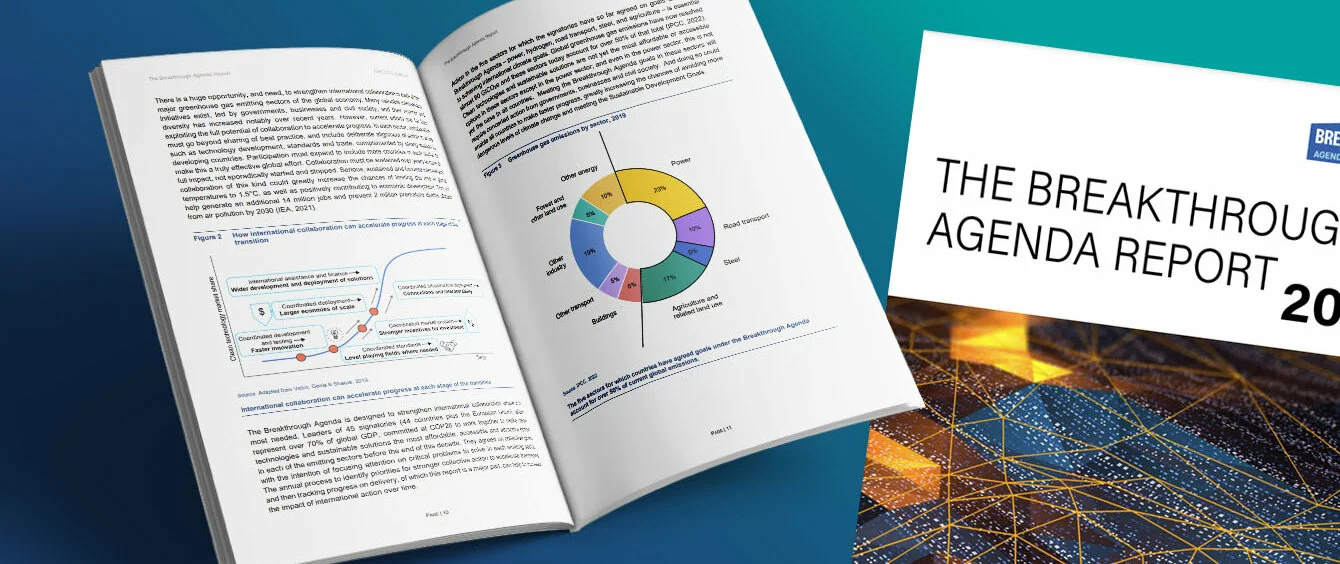At the 26th Conference of the Parties (COP 26) of the United Nations Framework Convention on Climate Change in Glasgow in 2021, the participating countries defined climate goals for 2030 in the Glasgow Climate Pact. Politicians attending the conference created the Breakthrough Agenda – a commitment to collaborate and promote the use of sustainable technologies.
The accord envisages the International Energy Agency (IEA), the International Renewable Energy Agency (IRENA) and the UN Climate Change High Level Champions compiling an annual report in which they jointly examine progress made in achieving the goals and identify areas requiring further international measures. The findings of the inaugural Breakthrough Agenda Report were recently published by the authoring organisations.
Need for action in five key sectors
The experts find that action must be taken above all in five sectors: energy, hydrogen, road transport, steel and agriculture. These areas alone are responsible for over 50 percent of current greenhouse gas emissions.
Greenhouse gas emissions by sector, 2019
in percent, source: IEATherefore, the authors have set priorities and identified the first set of measures for each of the sectors, with a view to hitting the targets established for these areas at COP 26. For example, the goals for the energy sector focus on the expansion, co-ordination and accessibility of clean technologies in developing countries. This is deemed indispensable to investing in the additional 7.4 to 8 terawatts (TW) of green energy required by 2030.
As regards hydrogen, however, the authors believe the countries should mainly prioritise building a bigger market for expanding and trading the fuel by stepping up collaboration. They propose that countries and businesses in sectors in which hydrogen can be used distance themselves from fossil fuels and share best practice in new applications such as steel and transportation.
In sum, the report contains 25 joint measures from all five sectors designed to spur clean energy, electric vehicles, hydrogen, low-carbon steel, and sustainable agriculture.
Positive effects of international collaboration
However, the experts also highlight some positive developments, for instance increasing international co-operation in recent years and progress in introducing necessary technologies. They forecast 8 percent growth in global renewable energy capacity for 2022. As a result, and due to the assets commissioned in 2021, the global cost of producing power will drop by at least 55 billion US dollars. Likewise, EV sales doubled year on year in 2021, reaching a record 6.6 million units sold.
But according to the IEA and IRENA, this will not suffice during the energy crisis. The agencies are convinced that long-term investment and collaboration must grow at the international level in order to strike a balance between security of supply and the expansion of renewables and prevent the energy transition from extending over decades. After all, although many countries have committed to ambitious net zero goals through to the middle of the century, global carbon dioxide emissions continue to increase slightly.
Intensified international co-operation needed
Alignment and co-ordination of measures at the multinational level could have a variety of positive effects: international support, financing and best practice sharing could accelerate developments. And some infrastructure projects planned and implemented internationally could help distribute green energy across country borders.
However, the report finds that the impact of current efforts is far from sufficient to tap into the full potential. International collaboration should be sustained for years instead of being initiated and ended sporadically.
